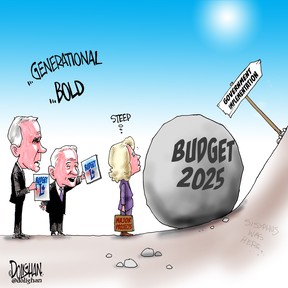Top Stories
Tim Dolighan’s Cartoon Sparks Debate on Political Satire

On November 6, 2025, cartoonist Tim Dolighan released a provocative cartoon that has ignited discussions about the role of political satire in contemporary society. The cartoon, which features a well-known political figure, has drawn both praise and criticism, highlighting the delicate balance between humor and offense in political commentary.
The artwork portrays the figure in an exaggerated manner, a technique commonly used in political cartoons to emphasize traits or opinions. Dolighan’s intention appears to be to provoke thought and discussion, but the response has been mixed. Supporters argue that the cartoon effectively captures the current political climate, while detractors claim it crosses the line into disrespect.
Social media platforms have become a battleground for these opinions. Many users have shared the cartoon, leading to extensive conversations about its implications. Some have hailed Dolighan as a champion of free speech, while others have accused him of perpetuating divisive narratives. The polarized reactions underscore the ongoing debate about the limits of satire and its impact on public discourse.
Artistic Intent vs. Public Reaction
Dolighan, known for his sharp wit and keen observational skills, often uses his work to comment on pressing social issues. In an interview following the release of the cartoon, he stated, “The purpose of satire is to challenge authority and provoke thought. If my work encourages dialogue, I consider that a success.”
This perspective raises questions about the responsibilities of artists in shaping public opinion. As political tensions rise globally, the line between humor and harm becomes increasingly complex.
The controversy surrounding Dolighan’s cartoon is not an isolated incident. Similar debates have emerged in various countries, where artists and public figures face scrutiny for their portrayals of political events and leaders. The rise of social media has amplified these discussions, allowing for immediate feedback and widespread dissemination of opinions.
Implications for Political Commentary
The broader implications of Dolighan’s cartoon extend beyond individual taste. It reflects a growing trend where political satire serves as both a mirror and a catalyst for societal change. As audiences become more engaged, the expectations for artists to navigate sensitive topics responsibly also increase.
In a world where information is rapidly consumed and opinions are swiftly formed, the balance between satire and respect is crucial. The ability of cartoons to influence public perception cannot be underestimated. As the discussion continues, it remains to be seen how Dolighan’s work will impact the future of political commentary and satire.
In conclusion, the release of Tim Dolighan’s cartoon on November 6, 2025, has sparked a vital conversation about the role of satire in politics. As public responses unfold, the artistic community will undoubtedly continue to grapple with the challenges and responsibilities that come with their craft.
-

 Lifestyle2 months ago
Lifestyle2 months agoWinnipeg Celebrates Culinary Creativity During Le Burger Week 2025
-

 Education2 months ago
Education2 months agoBrandon University’s Failed $5 Million Project Sparks Oversight Review
-

 Science3 months ago
Science3 months agoMicrosoft Confirms U.S. Law Overrules Canadian Data Sovereignty
-

 Health3 months ago
Health3 months agoMontreal’s Groupe Marcelle Leads Canadian Cosmetic Industry Growth
-

 Science3 months ago
Science3 months agoTech Innovator Amandipp Singh Transforms Hiring for Disabled
-

 Technology3 months ago
Technology3 months agoDragon Ball: Sparking! Zero Launching on Switch and Switch 2 This November
-

 Education3 months ago
Education3 months agoRed River College Launches New Programs to Address Industry Needs
-

 Technology4 weeks ago
Technology4 weeks agoDiscord Faces Serious Security Breach Affecting Millions
-

 Technology3 months ago
Technology3 months agoGoogle Pixel 10 Pro Fold Specs Unveiled Ahead of Launch
-

 Science3 months ago
Science3 months agoChina’s Wukong Spacesuit Sets New Standard for AI in Space
-

 Business2 months ago
Business2 months agoRocket Lab Reports Strong Q2 2025 Revenue Growth and Future Plans
-

 Education3 months ago
Education3 months agoAlberta Teachers’ Strike: Potential Impacts on Students and Families
-

 Technology3 months ago
Technology3 months agoWorld of Warcraft Players Buzz Over 19-Quest Bee Challenge
-

 Business3 months ago
Business3 months agoNew Estimates Reveal ChatGPT-5 Energy Use Could Soar
-

 Business3 months ago
Business3 months agoDawson City Residents Rally Around Buy Canadian Movement
-

 Technology1 month ago
Technology1 month agoHuawei MatePad 12X Redefines Tablet Experience for Professionals
-

 Technology3 months ago
Technology3 months agoFuture Entertainment Launches DDoD with Gameplay Trailer Showcase
-

 Science3 months ago
Science3 months agoXi Labs Innovates with New AI Operating System Set for 2025 Launch
-

 Technology3 months ago
Technology3 months agoInnovative 140W GaN Travel Adapter Combines Power and Convenience
-

 Business3 months ago
Business3 months agoBNA Brewing to Open New Bowling Alley in Downtown Penticton
-

 Technology3 months ago
Technology3 months agoGlobal Launch of Ragnarok M: Classic Set for September 3, 2025
-

 Technology3 months ago
Technology3 months agoNew IDR01 Smart Ring Offers Advanced Sports Tracking for $169
-

 Education2 months ago
Education2 months agoNew SĆIȺNEW̱ SṮEȽIṮḴEȽ Elementary Opens in Langford for 2025/2026 Year
-

 Technology3 months ago
Technology3 months agoArsanesia Unveils Smith’s Chronicles with Steam Page and Trailer










